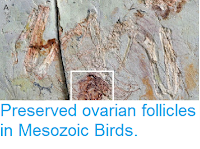Understanding the way in which animals develop is key to understanding the way in which they evolve, as changes in adult morphology are inevitably the result of changes in the way in which the young animal develops. This is well studied in modern animals, but much harder to study in extinct animals, as juveniles are often less readily available. This is particularly true for groups like Birds, where even the adults have rather fragile skeletons, making intact specimens very rare in the fossil record.
In a paper published in the journal Nature Communications on 5 March 2018, a group of scientists led by Fabien Knoll of the Fundación Conjunto Paleontológico de Teruel-Dinopolis and the School of Earth and Environmental Sciences at the University of Manchester, describe an Enantiornithine Bird Chick from the Early Cretaceous Las Hoyas Lagerstätte of eastern Spain.
The Las Hoyas is a Konservat-Lagerstätten (deposit producing numerous
excellently preserved fossils) of Barremian age (125-130 million years
old) formed in a stagnant, microbe rich lake. It is noted for its
excellently preserved vertebrate fossils, including Fish, Crocodiles,
Dinosaurs and Birds.
Birds derived from small Theropod Dinosaur ancestors in the Middle
Jurassic, and appear to have reached similar levels of diversity in the
Cretaceous to that seen today. However the dominant group of Birds in
the Cretaceous were the Enantiornithines, a group of mostly toothed Birds,
related to but not ancestral to modern Birds (Ornithuromorpha), which
died out in the end Cretaceous extinction event.
The specimen, MPCM-LH-26189, is not described as a new species, which can be problematic with juvenile animals, as it is hard to ascertain whether they belong to the same species as adults found separately. The specimen is preserved as part and counterpart on a split slab, and comprises a nearly complete and largely articulated skeleton, missing only the tips of the tail and limbs.
Overview photographs of the slab and counterslab of MPCM-LH-26189. Slab (a) is on the left, slab (b), on the right. The two red boxes indicate the localisation of the areas analysed histologically. Abbreviations: An: angular, Ar: articular, CaV: caudal vertebrae, CeV: cervical vertebrae, Co: coracoid, De: dentary, DoV: dorsal vertebrae, Fe: femur, Fr: frontal, Ga: gastralium, Hu: humerus, Hy: hyoid, Is: ischium, Ju: jugal, MiMC: minor metacarpal, Pu: pubis, Qu: quadrate, Ra: radius, Ri: rib, Sa: surangular, Sp: splenial, SaV: sacral vertebrae, SR: sclerotic ring, St: sternum, Ti: tibia, Ul: ulna. Knoll et al. (2018).
One of the distinctive structures of Enantiornithine Birds is their sternal complexes, which are made up of four-to-six ossified elements, and are different from those of both modern Birds and non-Avian Dinosaurs. In modern Birds, bones from the tail are recruited into the sternal complex as the individual grows, an ongoing process hard to spot in the fossil record. However, no known adult Enantiornithine Bird has more than eight free tailbones, whereas MPCM-LH-26189 has ten, strongly suggesting that more would have been recruited into the sternal complex as it grew.
Hypothetical fleshed-out reconstruction of MPCM-LH-26189. The fact that MPCM-LH-26189 is so well preserved and conserves some soft tissue associated chemistry, while showing no feathers or chemical evidence for plumage suggest that the baby bird might have been largely featherless when it died. However, this cannot be confirmed, and so the individual was reconstructed with juvenile plumage hypothesised for perinate Enantiornithines. The silhouettes inset are those of the juvenile Bird and an unspecified sympatric Cockroach to give a sense of scale. Raúl Martín in Knoll et al. (2018).
See also...
Follow Sciency Thoughts on Facebook.








